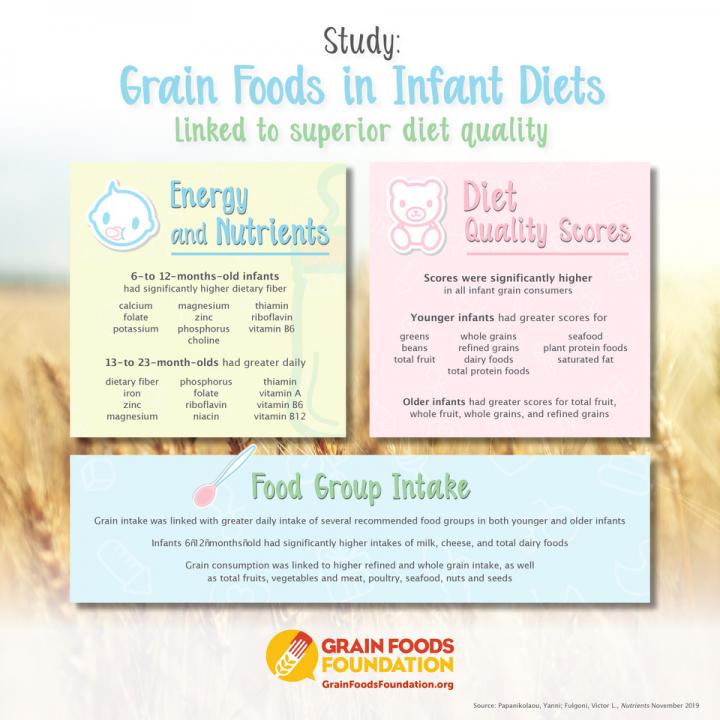The first-of-its-kind analysis demonstrates infant grain consumption linked to superior diet quality

Credit: Grain Foods Foundation
January 21, 2020 – Washington, DC – A new study recently published in Nutrients, a peer-reviewed medical journal of human nutrition, highlights the importance of grains as part of a healthy infant diet – and the potential risks of excluding them.
Undertaken to inform the development of the first-ever Dietary Guidelines for Americans (2020-2025) to include specific recommendations for infants and toddlers, the study analyzed infant data from the 2001-2016 National Health and Nutrition Examination Survey (NHANES) to assess grain food relationships with nutrient and energy intakes, diet quality, and food group consumption in infant grain consumers relative to non-consumers.
“This study is the first to examine grain consumption patterns among U.S. infants using NHANES and clearly provides evidence for what organizations, including the American Academy of Pediatrics and the CDC, have been suggesting for decades: grains support the backbone of a healthy infant diet,” says study author Yanni Papanikolaou, MPH, of Nutritional Strategies Inc. “In addition, the study highlights the many potential long-term nutrition-related health risks of eliminating or reducing grain foods from diets during one of the most crucial stages of growth and development.”
The study found grain consumption was generally associated with higher nutrient intakes, better diet quality scores and broader food group intake. Specifically:
- Energy and Nutrients
- 6- to 12-months-old infants had significantly higher dietary fiber, calcium, folate, potassium, magnesium, zinc, phosphorus, choline, thiamin, riboflavin, and vitamin B6 compared to non-consumers.
- 13- to 23-month-olds had greater daily dietary fiber, iron, zinc, magnesium, phosphorus, folate, riboflavin, niacin, thiamin, vitamin A, vitamin B6, and vitamin B12 relative to non-consumers.
- Diet Quality Scores
- Scores were significantly higher in all infant grain consumers examined in comparison to non-consumers.
- Younger grain-consuming infants typically ate more greens and beans, total fruit, whole grains, refined grains, dairy foods, total protein foods, seafood and plant protein foods, and saturated fat in comparison to non-consumers of grains.
- Older infants consuming grains typically ate more total fruit, whole fruit, whole grains, and refined grains relative to non-consumers.
- Food Group Intake
- Grain intake was linked with greater daily intake of several recommended food groups in both younger and older infants versus non-consumption of grains.
- Infants 6-12-months-old had significantly higher intakes of milk, cheese, and total dairy foods compared to grain non-consumers.
- Infant grain consumption was linked to higher refined and whole grain intake, as well as greater intake in terms of total fruits, total vegetables and total meat, poultry, seafood, nuts and seeds compared to non-consumers of grains.
Papanikolaou notes that the study included both whole grains and refined grains, as defined by the USDA Food Patterns Equivalents Database, in its analysis.
Taking a broad look at the data, he explains that while grains can be contributors of sugar and sodium to children’s’ diets, certain grain foods contribute high-value nutrient density that surpasses caloric contributions in the diet. As the American Academy of Pediatrics’ “whole diet approach” suggests, these foods can be made more palatable by adding small amounts of sugar, fat and sodium (for example, putting a bit of brown sugar on oatmeal).
As Papanikolaou concludes, early acceptance and familiarity with nutrient-dense whole grain and fortified or enriched refined grain foods (as opposed to “indulgent grains”) will likely help close nutrient intake recommendation gaps as children grow and develop – with particular emphasis on shortfall nutrients such as dietary fiber, folate, magnesium, calcium, and iron.
“The key takeaway of this study is that parents, caregivers, and those who provide them nutritional guidance need to know the many benefits of including, and the many risks of excluding, grains in infants’ diets,” concludes Papanikolaou.
The new published study in Nutrients can be found here.
The Grain Foods Foundation provided funding support for this research. For more information about the research findings, and to learn more about grain foods’ role in a healthful diet, please visit http://www.
###
About Grain Foods Foundation
Formed in 2004, Grain Foods Foundation (GFF) is a group of thought leaders and advocates for all grain foods and believes everybody needs grain food to enjoy a happy and healthy life. Committed to nutrition education programming that is firmly rooted in science, GFF is a strong advocate for our members and a resource for consumers and the media who want to learn more about the role of grains in a well-balanced eating pattern. GFF offers research-based information and resources to members, partners, influencers, policymakers and consumers through a comprehensive communications campaign, conferences, webinars, research tools, social media and more. GFF is committed to bringing fact-based information and common sense to the consumer. For more information, visit http://www.
Media Contact
Grain Foods Foundation
[email protected]
Original Source
https:/
Related Journal Article
http://dx.




